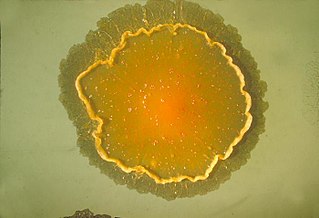Related Research Articles

Bacillus is a genus of Gram-positive, rod-shaped bacteria, a member of the phylum Bacillota, with 266 named species. The term is also used to describe the shape (rod) of other so-shaped bacteria; and the plural Bacilli is the name of the class of bacteria to which this genus belongs. Bacillus Addie Daly. obligate aerobes which are dependent on oxygen, or facultative anaerobes which can survive in the absence of oxygen. Cultured Bacillus species test positive for the enzyme catalase if oxygen has been used or is present.

In biology and genetics, the germline is the population of a multicellular organism's cells that pass on their genetic material to the progeny (offspring). In other words, they are the cells that form the egg, sperm and the fertilised egg. They are usually differentiated to perform this function and segregated in a specific place away from other bodily cells.

Streptomyces is the largest genus of Actinomycetota and the type genus of the family Streptomycetaceae. Over 500 species of Streptomyces bacteria have been described. As with the other Actinomycetota, streptomycetes are gram-positive, and have genomes with high GC content. Found predominantly in soil and decaying vegetation, most streptomycetes produce spores, and are noted for their distinct "earthy" odor that results from production of a volatile metabolite, geosmin.

Burkholderia is a genus of Pseudomonadota whose pathogenic members include the Burkholderia cepacia complex, which attacks humans and Burkholderia mallei, responsible for glanders, a disease that occurs mostly in horses and related animals; Burkholderia pseudomallei, causative agent of melioidosis; and Burkholderia cepacia, an important pathogen of pulmonary infections in people with cystic fibrosis (CF). Burkholderia species is also found in marine environments. S.I. Paul et al. (2021) isolated and characterized Burkholderia cepacia from marine sponges of the Saint Martin's Island of the Bay of Bengal, Bangladesh.
Fibrobacterota is a small bacterial phylum which includes many of the major rumen bacteria, allowing for the degradation of plant-based cellulose in ruminant animals. Members of this phylum were categorized in other phyla. The genus Fibrobacter was removed from the genus Bacteroides in 1988.

Mycobacterium marinum is a slow growing mycobacterium (SGM) belonging to the genus Mycobacterium and the phylum Actinobacteria. The strain marinum was first identified by Aronson in 1926 and it is observed as a pathogenic mycobacterium. For example, tuberculosis like infections in fish (mycobacteriosis) and skin lesions in humans.

Tumor protein p63, typically referred to as p63, also known as transformation-related protein 63 is a protein that in humans is encoded by the TP63 gene.

Virophages are small, double-stranded DNA viral phages that require the co-infection of another virus. The co-infecting viruses are typically giant viruses. Virophages rely on the viral replication factory of the co-infecting giant virus for their own replication. One of the characteristics of virophages is that they have a parasitic relationship with the co-infecting virus. Their dependence upon the giant virus for replication often results in the deactivation of the giant viruses. The virophage may improve the recovery and survival of the host organism.
Tristromaviridae is a family of viruses. Archaea of the genera Thermoproteus and Pyrobaculum serve as natural hosts. Tristromaviridae is the sole family in the order Primavirales. There are two genera and three species in the family.
Oceanobacillus is a Gram-positive, rod-shaped and motile bacteria genus from the family of Bacillaceae with a peritrichous flagella. Oceanobacillus species are commonly found in saline environment.
Carboxydothermus is a genus of thermophilic, anaerobic bacteria from the family of Thermoanaerobacteraceae.
Thalassobacillus is a Gram-positive, oxidase positive, catalase negative, rod shaped and moderately halophilic genus of bacteria from the family of Bacillaceae. Single colonies are small in size.Thalassobacillus bacteria produces Meso-diaminopimelic acid. S.I. Paul et al. (2021) isolated and biochemically characterized Thalassobacillus devorans from marine sponges of the Saint Martin's Island of the Bay of Bengal, Bangladesh.

Mycobacterium ulcerans is a species of bacteria found in various aquatic environments. The bacteria can infect humans and some other animals, causing persistent open wounds called Buruli ulcer. M. ulcerans is closely related to Mycobacterium marinum, from which it evolved around one million years ago, and more distantly to the mycobacteria which cause tuberculosis and leprosy.
Cytobacillus is a genus of rod-shaped bacteria that stain either Gram-positive or Gram-variable in the family Bacillaceae within the order Bacillales. The type species for this genus is Cytobacillus firmus.
Ectobacillus is a genus of Gram-positive, rod-shaped bacteria in the family Bacillaceae within the order Bacillales. The type species for this genus is Ectobacillus panaciterrae.
Evansella is a genus of Gram-positive rod-shaped bacteria in the family Bacillaceae within the order Bacillales. The type species for this genus is Evansella cellulosilytica.
Ferdinandcohnia is a genus of rod-shaped bacteria that generally display Gram-positive staining in the family Bacillaceae within the order Bacillales. The type species for this genus is Ferdinandcohnia humi.
Niallia is a genus of Gram-Positive rod-shaped bacteria in the family Bacillaceae from the order Bacillales. The type species of this genus is Niallia circulans.
Alkalicoccus is a genus of Gram-Positive rod-shaped bacteria in the family Bacillaceae from the order Bacillales. The type species of this genus is Alkalicoccus saliphilus.
Aneurinibacillus migulanus is a bacterium from the genus of Aneurinibacillus. Aneurinibacillus migulanus produces the antibiotic Gramicidin S. Genome size of Aneurinibacillus migulanus strain TP115 is 5,556,554 bp.
References
- 1 2 3 4 5 6 7 8 9 10 11 "Genus: Aneurinibacillus". LPSN.DSMZ.de.
- ↑ "Aneurinibacillus". www.uniprot.org.
- ↑ "Aneurinibacillus - an overview". ScienceDirect Topics.
- ↑ Vos, Paul; Garrity, George; Jones, Dorothy; Krieg, Noel R.; Ludwig, Wolfgang; Rainey, Fred A.; Schleifer, Karl-Heinz; Whitman, William B. (28 January 2011). Bergey's Manual of Systematic Bacteriology: Volume 3: The Firmicutes. Springer Science & Business Media. p. 300. ISBN 978-0-387-68489-5.
- ↑ Paul, Sulav Indra; Rahman, Ashikur; Rahman, M. Mahbubur (2022-10-27). Stewart, Frank J. (ed.). "Whole-Genome Sequence of Aneurinibacillus migulanus TP115, a Potential Fish Probiotic Isolated from Oreochromis niloticus Gut". Microbiology Resource Announcements. 11 (11): e00861–22. doi:10.1128/mra.00861-22. ISSN 2576-098X. PMC 9670894 . PMID 36301117.